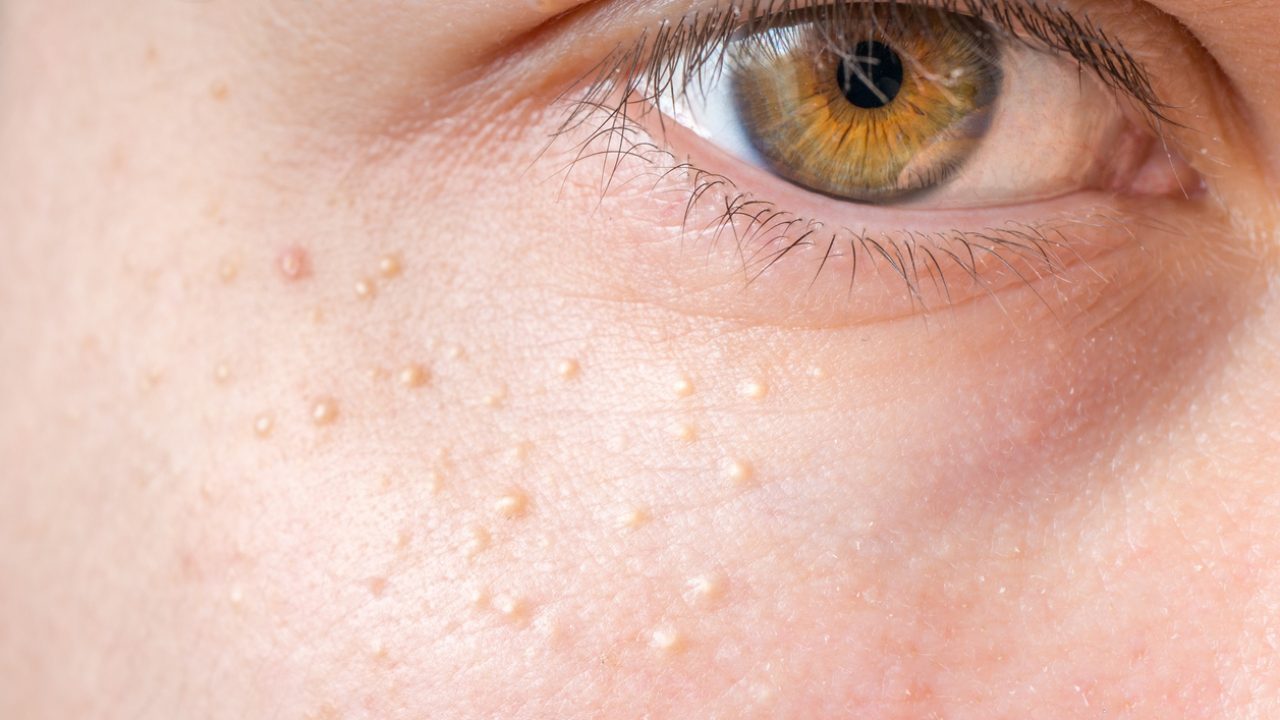
Since being in lockdown, we’ve definitely been paying more attention to our skin and now that we’re not wearing makeup everyday, we’ve noticed we’ve developed a skin condition we hadn’t seen before – milia.
Also known as milia spots, these are small white bumps under the skin around our eyes that don’t look too dissimilar to tiny whiteheads. They’re extremely common in newborn babies but many older children and adults get them at various points in their lives.
If this sounds familiar, you may also have milia but before you go squeezing them assuming their pimples, read our guide to what causes them and how to get rid of them safely.
READ NEXT: What causes acne and how to get rid of it
A milium cyst is a small – usually between 1-2mm wide – white bump that appears under the skin. You can get individual cysts, or these cysts can also group together forming what’s known as milia.
Milia isn’t a painful or itchy condition and typically the level of discomfort depends on the size and texture of the cysts – whether they are small and flat, or larger bumps which could catch on clothing or when you’re washing your face.
Many people think milia only occurs in newborn babies (when they’re often referred to as milk spots) but older children and adults are susceptible too.
According to Bianca Estelle, founder and director of bea Skin Clinic, this skin condition is caused by an excess build-up of keratin that gets trapped under the skin.
Commonly found around the nose, eye area and on your cheeks, you may also find them anywhere on the face or other parts of the skin.
Causes can also include blistering injuries (such as poison ivy), burns, sun damage, use of steroid creams over a long period of time or skin resurfacing procedures.
Primary milia are the smaller cysts which are formed directly from the trapped keratin. Secondary milia tend to occur after a more severe upset to the skin’s surface such as a burn or blister.
FURTHER READING: How to get rid of spots fast with this failsafe makeup artist tip
Milia tends to go away on its own after a few weeks but there are a couple of things you can do to get rid of milia a little faster.
“Always cleanse your skins with a product that has exfoliating properties,” Bianca told mamabella.
She recommends either her own bea Skin Care’s Gentle Exfoliating Cleanser, or any serum that contains retinol (vitamin A). AHA’s (alpha hydroxy acids) such as glycolic acid or lactic acid also work well.
We’re big fans of the La Roche-Posay Effaclar Purifying Cleansing Gel (£12.50 at Boots) as well as The Inkey List’s Lactic Acid serum (£9.99).
READ NEXT: Best cleanser for all skin types
The latter is a little stronger in formulation so may not be suitable for really sensitive skin but the former is perfect for acne-prone skin and blemishes.
“You could also opt for salicylic acid which works well for sensitive skin types. Once treated, milia can be managed and usually prevented from returning,” Bianca added.
If you feel only a few bumps cropping up, it might be worth tracking back through your skincare regime as of late.
You might realise you’ve been slacking on using your eye cream or dropped the exfoliating step.
Chemical peels are another option for solution to your milia problems – as many include AHAs and glycolic acid. We absolutely swear by Dr Dennis Gross’ Alpha Beta Universal Daily Peel.
It combines five alpha- and beta-hydroxy acids (AHAs and BHAs) with antioxidants including retinol, ubiquinone and resveratrol.
As the name suggests, this is gentle enough to use daily and the two-step process helps clear your complexion.
They’re not cheap though, coming in at £19 for five – but we think it’s worth it.
There are also a variety of other at-home chemical peels but if you’ve not tried any before, tread carefully, read all instructions and – if you’re anxious – save your first chemical peel for a salon visit.
Regarding treating milia professionally, Bianca said that in her clinic, milia removal involves using a sterilised needle that carefully extracts the milia from under the surface of your skin.
There is also an alternative method of treatment known as Cryopen or Cryotherapy ‘which uses liquid nitrogen to freeze and destroy the milia’.
Either way, Bianca added that milia is a common skin condition and so the treatments are common procedures.
If the cysts are only tiny bumps, it’s worth looking at what eye cream you’re using because some experts believe that too heavy a cream on this sensitive area can, in fact, be a cause of the milia in the first place.
Other steps can easily be incorporated into your skincare regime to help prevent or minimise milia – such as gentle exfoliation and retinol creams. Reducing your skin’s exposure to the sun can also help.

Amira Arasteh is a freelance journalist and content creator. Find her making sense of beauty trends, tips and topics – when she’s not stuffing her face with the best food in London or travelling the globe

